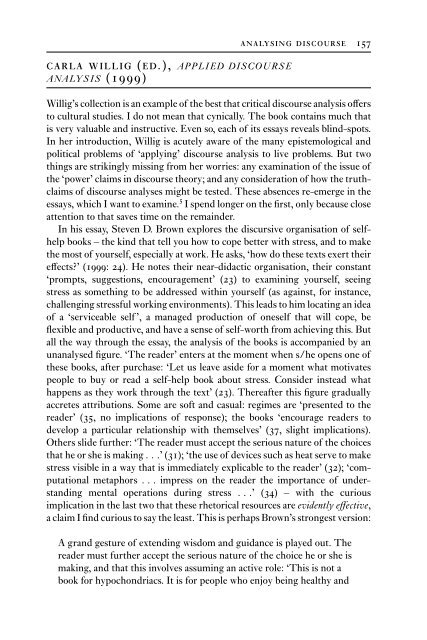Research Methods for Cultural Studies
Research Methods for Cultural Studies
Research Methods for Cultural Studies
You also want an ePaper? Increase the reach of your titles
YUMPU automatically turns print PDFs into web optimized ePapers that Google loves.
carla willig (ed.), APPLIED DISCOURSE<br />
ANALYSIS (1999)<br />
analysing discourse 157<br />
Willig’s collection is an example of the best that critical discourse analysis offers<br />
to cultural studies. I do not mean that cynically. The book contains much that<br />
is very valuable and instructive. Even so, each of its essays reveals blind-spots.<br />
In her introduction, Willig is acutely aware of the many epistemological and<br />
political problems of ‘applying’ discourse analysis to live problems. But two<br />
things are strikingly missing from her worries: any examination of the issue of<br />
the ‘power’ claims in discourse theory; and any consideration of how the truthclaims<br />
of discourse analyses might be tested. These absences re-emerge in the<br />
essays, which I want to examine. 5 I spend longer on the first, only because close<br />
attention to that saves time on the remainder.<br />
In his essay, Steven D. Brown explores the discursive organisation of selfhelp<br />
books – the kind that tell you how to cope better with stress, and to make<br />
the most of yourself, especially at work. He asks, ‘how do these texts exert their<br />
effects?’ (1999: 24). He notes their near-didactic organisation, their constant<br />
‘prompts, suggestions, encouragement’ (23) to examining yourself, seeing<br />
stress as something to be addressed within yourself (as against, <strong>for</strong> instance,<br />
challenging stressful working environments). This leads to him locating an idea<br />
of a ‘serviceable self ’, a managed production of oneself that will cope, be<br />
flexible and productive, and have a sense of self-worth from achieving this. But<br />
all the way through the essay, the analysis of the books is accompanied by an<br />
unanalysed figure. ‘The reader’ enters at the moment when s/he opens one of<br />
these books, after purchase: ‘Let us leave aside <strong>for</strong> a moment what motivates<br />
people to buy or read a self-help book about stress. Consider instead what<br />
happens as they work through the text’ (23). Thereafter this figure gradually<br />
accretes attributions. Some are soft and casual: regimes are ‘presented to the<br />
reader’ (35, no implications of response); the books ‘encourage readers to<br />
develop a particular relationship with themselves’ (37, slight implications).<br />
Others slide further: ‘The reader must accept the serious nature of the choices<br />
that he or she is making . . .’ (31); ‘the use of devices such as heat serve to make<br />
stress visible in a way that is immediately explicable to the reader’ (32); ‘computational<br />
metaphors . . . impress on the reader the importance of understanding<br />
mental operations during stress . . .’ (34) – with the curious<br />
implication in the last two that these rhetorical resources are evidently effective,<br />
a claim I find curious to say the least. This is perhaps Brown’s strongest version:<br />
A grand gesture of extending wisdom and guidance is played out. The<br />
reader must further accept the serious nature of the choice he or she is<br />
making, and that this involves assuming an active role: ‘This is not a<br />
book <strong>for</strong> hypochondriacs. It is <strong>for</strong> people who enjoy being healthy and


